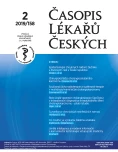The role of single-operator cholangioscopy (SpyGlass) in the intraoperative diagnosis of intraductal borders of cholangiocarcinoma proliferation – pilot study
Authors:
Jan Hajer 1; Lukáš Havlůj 2; Adam Whitley 2; Martin Oliverius 2; Robert Gürlich 2
Authors‘ workplace:
2. interní klinika 3. LF UK a FN Královské Vinohrady, Praha
1; Chirurgická klinika 3. LF UK a FN Královské Vinohrady, Praha
2
Published in:
Čas. Lék. čes. 2019; 158: 68-72
Category:
Original Articles
Overview
Cholangiocarcinoma is a relatively rare, highly fatal neoplasm originating from the biliary epithelium. Its only potentially curative treatment option is a radical surgical resection. The aim of our work was to evaluate the feasibility and the safety of intraoperative ERCP and direct cholangioscopy (SpyGlass) to assess the intraductal border of cholangiocarcinoma proliferation.
The study ran from November 2015 to January 2018. The group included patients with histologically verified cholangiocarcinoma and, based on available examinations, the resectability of the tumor was assessed by a multidisciplinary team. In cases of indicated surgical resection we peroperatively performed ERCP with cholangioscopy SpyGlass and "diaphanoscopy" in all patients. The resectability was assessed on the basis of these examinations and the peroperative surgical findings. The resection procedure itself was performed only in 2 out of the total of 14 patients, as other patients were indicated for the implantation of metallic SEMS within the ERCP procedure in the operating room instead. To validate the cholangioscopic findings, we used our own criteria based on both the Monaco and other criteria. We divided the findings according to the presence or absence of ulceration, prominent polyposis, pathological vascularization (4 types), pressure defect with a coagulum in the presence of previous stent implantation, papillomatous changes or discolorations of the mucosa.
Out of the total number of 14 patients only two patients were indicated for resection and in both cases R0 resection was achieved. The remaining patients were intraoperatively indicated for palliative implantation of SEMS based on the same unresectable finding during cholangioscopy and laparotomy.
We demonstrated the technical feasibility and safety of direct peroperative cholangioscopy. Our results show that direct perioperative cholangioscopy is one of the methods which can contribute to a more accurate determination of tumor spread margins.
Keywords:
cholangiocarcinoma – direct cholangioscopy – ERCP – intraductal ultrasonography
Sources
- Singh A, Gelrud A, Agarwal B. Biliary strictures: diagnostic considerations and approach. Gastroenterology report 2014; 3(1): 22–31.
- Wakai T, Shirai Y, Sakata J et al. Clinicopathological features of benign biliary strictures masquerading as biliary malignancy. Am Surg 2012; 78: 1388–1391.
- Rauws EAJ, Kloek JJ, Gouma DJ, Van Gulik TM. Staging of cholangiocarcinoma: the role of endoscopy. HPB 2008; 10(2): 110–112.
- Voaklander R, Kim E, Brown WH et al. An Overview of the evolution of direct cholangioscopy techniques for diagnosis and therapy. Gastroenterol Hepatol 2016; 12(7): 433–437.
- Franzini TA, Moura RN, de Moura EG. Advances in therapeutic cholangioscopy. Gastroenterol Res Pract 2016: 5249152.
- Ogawa T, Ito K, Koshita S et al. Usefulness of cholangioscopic-guided mapping biopsy using SpyGlass DS for preoperative evaluation of extrahepatic cholangiocarcinoma: a pilot study. Endosc Int Open 2018; 6(2): e199–e204.
- Vítek P, Urban O, Hucl T a kol. Cholangiopankreatikoskopie – doporučený postup České gastroenterologické společnosti ČLS JEP. Gastroenterologie a hepatologie 2018; 72(3): 199–204.
- Sethi A, Shah R, Itoi T et al. Defining imaging criteria for indeterminate biliary strictures utilizing video cholangioscopy: the Monaco classification. Gastrointest Endosc 2015; 81(Suppl. 5): AB188–AB189.
- Siddiqui AA, Mehendiratta V, Jackson W et al. Identification of cholangiocarcinoma by using the Spyglass Spyscope system for peroral cholangioscopy and biopsy collection. Clin Gastroenterol Hepatol 2012; 10: 466–471.
- Urban O, Fojtík P, Mikolajek O, Arnelo U. Renesance cholangiopankreatoskopie a nové možnosti intraduktální endoskopické terapie. Gastroent Hepatol 2016; 70: 203–207.
- Moon JH, Terheggen G, Choi HJ et al. Peroral cholangioscopy: diagnostic and therapeutic applications. Gastroenterology 2013; 144: 276–228.
- Meister T, Heinzow HS, Woestmeyer C et al. Intraductal ultrasound substantiates diagnostics of bile duct strictures of uncertain etiology. World J Gastroenterol 2013; 19(6): 874–881.
- Nakazawa T, Naitoh I, Hayashi K. Usefulness of intraductal ultrasonography in the diagnosis of cholangiocarcinoma and IgG4-related sclerosing cholangitis. Clin Endosc 2012; 45(3): 331–336.
- Urban O, Arnelo U, Fojtík P et al. Cholangiopankreatikoskopie pomocí SpyGlass direct visualisation system: seznámení s metodou a první vlastní zkušenosti. Gastroenterologie a hepatologie 2013; 67(2): 124–126.
- Parsi MA. Direct peroral cholangioscopy. World J Gastrointest Endosc 2014; 6(1): 1–5.
- Tamada K, Ido K., Ueno N., et al. Assessment of portal vein invasion by bile duct cancer using intraductal ultrasonography. Endoscopy 1995; 27: 573–578.
- Van Beers BE. Diagnosis of cholangiocarcinoma. HPB 2008; 10(2): 87–93.
- Sun B, Hu B. The role of intraductal ultrasonography in pancreatobilliary diseases. Endosc Ultrasound 2016; 5: 291–299.
Labels
Addictology Allergology and clinical immunology Angiology Audiology Clinical biochemistry Dermatology & STDs Paediatric gastroenterology Paediatric surgery Paediatric cardiology Paediatric neurology Paediatric ENT Paediatric psychiatry Paediatric rheumatology Diabetology Pharmacy Vascular surgery Pain management Dental HygienistArticle was published in
Journal of Czech Physicians

2019 Issue 2
Most read in this issue
- Surgery for cholangiocarcinoma
- Pathology of cholangiocellular carcinoma
- Artificial intelligence and modern information and communication technologies entering medicine
- Epidemiology of gallbladder and bile duct malignancies in the Czech Republic
